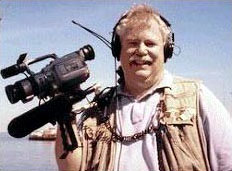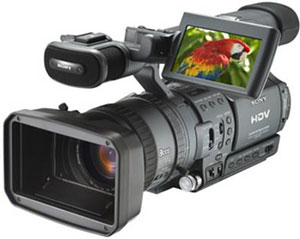 |
→ January 2005 Contents → Camera Corner
|
Camera Corner
January 2005
|
 |
|
Since the arrival of miniDV in 1995, a revolution in the way we document our world has transpired. I've said it before, I'll say it again: miniDV has democratized the filmmaking process. You don't have to buy, process and print expensive film. You don't have to buy or rent $30,000 video cameras. You can record your vision on cheap tapes with a cheap camera and get stunning images. There's been a recent development on the DV front that I believe is beyond evolutionary. It is downright revolutionary. And that is the introduction of high definition miniDV.
What makes Sony's entry into the market so exciting is that 1) it's a Sony, and 2) it's a well-thought-out camera with a great many features, including native 16:9 chips. It's already available for about $3,500. Better still, the FX1 is simply a consumer version of the soon-to-be-introduced HVR-Z1U professional version (think VX2100 vs. PD170), with still more features, including XLR inputs and user settable timecode. A companion VTR, the HVR-M10U, will hit the market at the same time. The Z1 is similar in shape and size to the PD-170. But in many respects, that's where the similarity ends. The camera has a 12x Zeiss Vario-Sonnar T*, which ought to be very sharp. It has three 16:9 megapixel CCDs. The wide-screen viewfinder is switchable between color and B&W. But you also get a 3.5-inch swing-out LCD view screen. You can use both at the same time; a boon. And you get a TV safe area marker as well. A really good feature on the Z1 is the "non-perpetual" focusing ring. This means that the ring has a start point and an end point, rather than spinning around forever. This is important because focusing in high def is critical. Unlike JVC's HD1, the Z1 records in a variety of formats and modes: HDV, DVCam, miniDV; scanning at 1080/60i or 50i (NTSC/PAL); 480i; 30, 25 and 24fps. While the camera does not record progressive scan, early reports indicate the 24fps interlaced "CineFrame" mode looks as good as any 24p image. There are extensive function controls for things like gamma, tone, hue, saturation, video level, audio level, ad infinitum. You can even select the color of your peaking indicator (zebra), from among white, red and yellow. The user settable timecode modes are a nice touch. In terms of connectors, the Z1 has RGB component, S-Video, A/V and i-Link (IEEE1394 Firewire). A built-in down converter lets you output your HDV images directly to SD, for viewing on a standard monitor or dubbing to a standard deck. Despite all these features, the Z1 can run over 5 hours on a single battery, with both the LCD and EVF on. On the down side, the camera does not have great low-light capabilities. Compare its minimum illumination of 3 lux to the PD-170's 1 lux. Though I've not seen the new Sony Z1, people who have say it's nothing short of amazing, with picture quality to match. When the camera comes out in February, don't expect much of a discount off the $5,900 price, at least not initially. The companion M10 deck will go for $3,700. Panasonic, which broke new ground with its wildly popular SD VX100 24p camcorder, must now make a move into some iteration of HDV or risk losing market share. It will certainly be a 720p camera, but who knows what else the engineers at Matsushita have up their sleeves? So why is this revolutionary? Until now, shooting high definition was hugely expensive and involved a very complicated production/post-production process. Sony has made HD life much easier, putting it within reach of the average filmmaker and VJ. This may very well be the final piece of the convoluted high definition puzzle, the link that will spur us all to adopt HD as our viewing medium of choice.
© Steven Trent Smith
|
|
Back to January 2005 Contents
|
|
 JVC kicked all this off in the summer of 2003 when they brought out their 720p GR-HD1US. While the world was excited by the new format, not many people adopted it.
This summer, Sony officially unveiled its take on the miniDV format, introducing the 1080i HDR-FX1 camcorder. And all the world is abuzz again.
JVC kicked all this off in the summer of 2003 when they brought out their 720p GR-HD1US. While the world was excited by the new format, not many people adopted it.
This summer, Sony officially unveiled its take on the miniDV format, introducing the 1080i HDR-FX1 camcorder. And all the world is abuzz again.